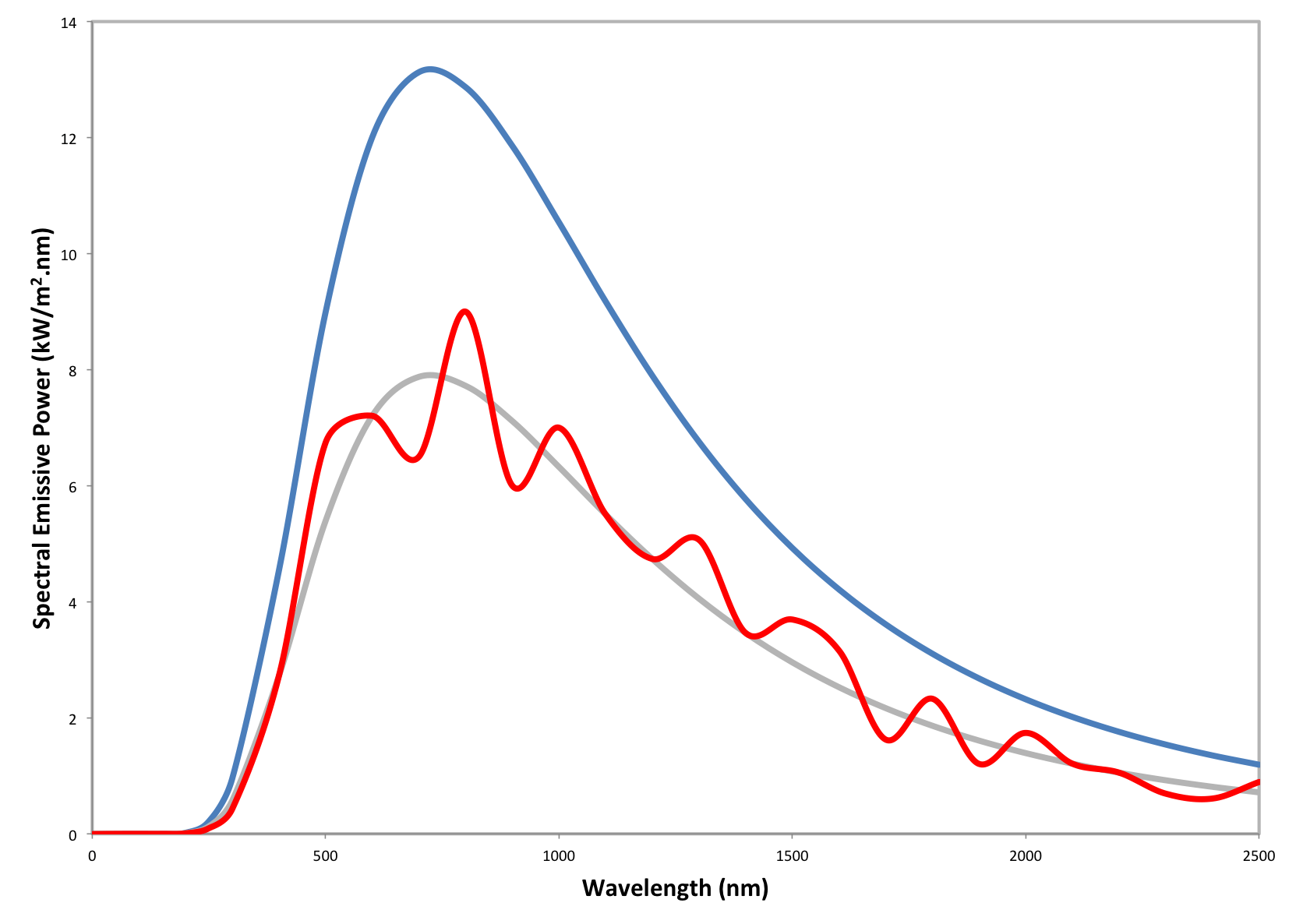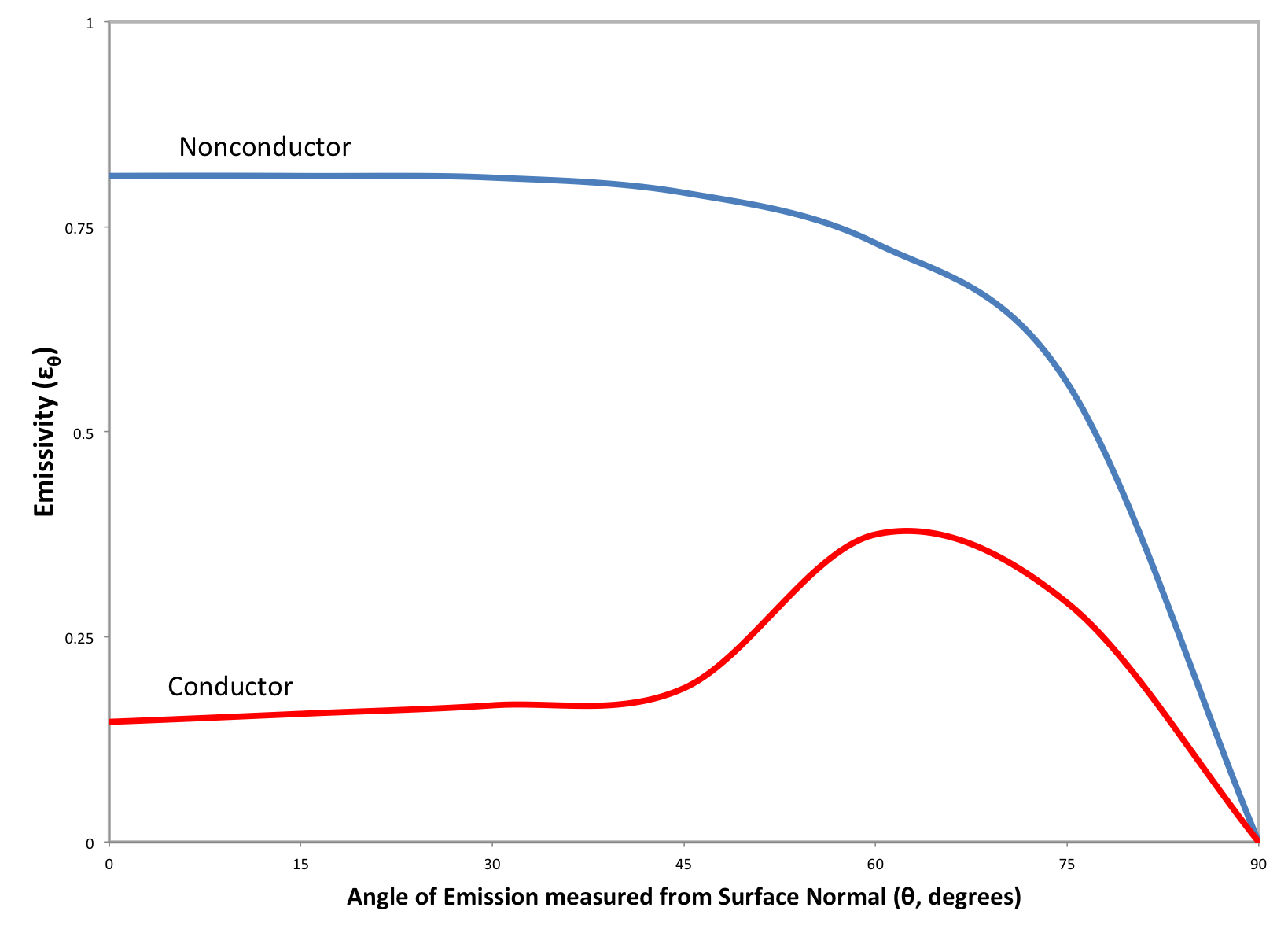Summary
At any given temperature, real materials emit less energy than that of a black body. The effectiveness of a material at emitting energy is represented by a radiative property called the emissivity factor, which is the ratio of the actual energy emission of the material to that of a blackbody at the same temperature. This article will provide an overview of emissivity and its many formulations.
Definitions
| E | : | Emissive Power |
| I | : | Intensity of radiation |
| : | Emissivity (dimensionless) | |
| : | Stefan-Boltzmann constant | |
| : | Temperature (K) | |
| : | Wavelength of radiation | |
| : | The polar angle (radians, ) | |
| : | The azimuthal angle (radians, ) |
Subscripts:
| b | : | Indicates that a component is evaluated for a blackbody |
| : | Indicates a component is spectrally dependent i.e. a function of wavelength | |
| : | Indicates a component is directionally dependent i.e. a function of direction of emission |
Introduction
Emissivity ( ) is the ratio of radiation emitted by a surface to that emitted by a blackbody at the same temperature. As a blackbody emits the maximum amount of radiation possible over all wavelengths, emissivity lies in the range .
Emissivity provides a simple method by which the emission characteristics of a non-ideal surface can be related back to the idealised blackbody. For example the total emissive power ( ) of a real surface can be expressed as the product of the total emissive power of a black body ( ) and the total hemispherical emissivity as follows:
However, in reality emission of radiation from a real surface is quite complex, being a function of surface temperature, radiation wavelength and the direction of emission. Considering spectral (wavelength) dependence alone, deviation of the emissive power for a real surface from that of a black or gray body can be pronounced.
The inherent difficulties in characterising emissivity across all four of its dependencies has led to the development and use of the gray surface and diffuse surface simplifying assumptions, which will be detailed in the subsequent sections.
Glossary
The nomenclature and language used to discuss emissivity and radiative heat transfer in general varies between source materials, however there are several fundamental terms used in reference to emissivity:
Spectral - Indicates a component is specified at a single wavelength (monochromatic). A component description will use the modifier ‘spectral’ and be denoted with the subscript if it is a function of wavelength.
Directional - Indicates a component is specified for a particular direction. A component description will use the modifier ‘directional’ and be denoted with the subscript if it is a function of direction of emission. Direction is typically noted using polar angles and which measure deviation of radiation direction from the surface normal.
Total Emissivity - Emissivity averaged across all wavelengths.
Hemispherical Emissivity - Emissivity averaged across all directions.
Total Hemispherical Emissivity - Emissivity averaged across all wavelengths and directions.
Diffuse - The assumption that the intensity of emitted, reflected and incident radiation is independent of radiation direction (i.e. emissivity is constant across all directions).
Gray Surface - The assumption that absorptivity and emissivity are independent of wavelength (i.e. emissivity is constant across all wavelengths).
Additionally these definitions can be combined to form compound approximations for the emission of radiative heat transfer. For example a surface can be described as a gray, diffuse surface meaning that its emissivity is independent of both wavelength and direction and therefore only a function of temperature.
Emissivity Formulations
Summary of Emissivity Approximations
There are 4 primary emissivity formulations which vary by whether or not they assume emissivity to be constant for all wavelengths or all directions. A summary is shown in the table below followed by a detailed description of each formulation.
| Surface | ||
|---|---|---|
| Real | ≠ constant | ≠ constant |
| Gray | ≠ constant | constant |
| Diffuse | constant | ≠ constant |
| Diffuse, Gray | constant | constant |
Spectral-Directional Emissivity (Real Surface)
The emission of thermal radiation from real surfaces is a complex phenomena and has spectral ( ), directional ( , ) and temperature ( ) dependence. When dependence on all four parameters is considered the spectral-directional emissivity is used to calculate radiant heat transfer. Remembering that emissivity is the ratio of emission from a real surface to that of a blackbody the spectral-directional emissivity may be defined as shown below.
Due to the inherent difficulties in characterising emission across four dimensions the spectral-directional emissivity is seldom used. Instead independence of one or more parameters is assumed with the specific assumption taken being dependent on the characteristics of the emitting surface.
Total Emissivity (Gray Surface)
For some materials, treatment of emission can be simplified by assuming that the emissivity is spectrally independent i.e. emissivity is constant with respect to wavelength. In this case the simplified emissivity is called the directional emissivity and represents the ‘spectral average’ of emission and hence the common name of this assumption; the gray surface approximation (wavelength of radiation determines colour and the ‘average’ of all colours is gray). The directional emissivity can be defined as below.
A gray surface should emit the same amount of radiation as the real surface it approximates at the same temperature. Therefore the directional (gray) emissivity should be selected such that area under the emission curves is equal to the area above it (see figure below).
Spectral Hemispherical Emissivity (Diffuse Surface)
Where appropriate the assumption that emission characteristics are independent of the direction of emission ( ) can be made. The resulting emissivity is called the spectral hemispherical emissivity and surfaces that use this approximation are said to be diffuse i.e. emission is the same in all directions. The spectral hemispherical emissivity can be defined as below.
Although real surfaces do not exhibit perfectly diffuse emission like a black body they can come close, particularly the more acute the angle of emission. This is demonstrated in the figure below which shows the variation in emissivity with emission direction for generalised electrical conductors and nonconductors.
Here the emissivity is nearly constant when the emission angle deviates from the surface normal by less than and from for conductors and nonconductors respectively. It is common practice to use the diffuse emitter assumption as it greatly simplifies analysis while providing a reasonable approximation for many real surfaces. However, it should be noted that no real surface can be a perfect diffuse emitter as electromagnetic wave theory predicts no emittance at .
Total Hemispherical Emissivity (Diffuse, Gray Surface)
Finally, by making the further simplification that emission is independent of both emission angle (diffuse) and the wavelength (gray), we have the total hemispherical emissivity, which represents the average emissivity over all wavelengths and directions, as defined below.
Total hemispherical emissivity is the equivalent of saying a surface is both gray and diffuse and is the common entry point for radiative analysis as it allows emissivity to be summarised in a single number and can be experimentally determined relatively simply by measuring radiation emitted by a surface as a whole rather than as a function of wavelength and/or emission direction.
Further Reading
- Heat Transfer Handbook
- Heat Transfer A Practical Approach
- Chemical Engineering Volume 1, Sixth Edition: Fluid Flow, Heat Transfer and Mass Transfer
- Radiative Heat Transfer, Third Edition
Article Tags


